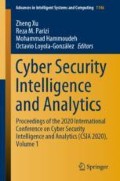Abstract
Aiming at improve the signal transmission quality of wireless communication networks, blind signals need to be separated in real time. A hybrid blind signal separation algorithm based on high order statistic blind source separation under complex electromagnetic interference is proposed. The hybrid blind signal model of wireless communication network is constructed under complex electromagnetic environment interference. The fourth order cumulant is used to decompose the insensitivity of the mixed blind signal, which effectively suppresses the complex electromagnetic pulse interference. The blind separation of mixed signal is realized by using time-frequency decomposition method. The real-time separation performance of signal is realized. The proposed method brings improved blind separation ability, reduced bit error rate and enhanced communication quality of the wireless communication network.
Access this chapter
Tax calculation will be finalised at checkout
Purchases are for personal use only
References
Houg, X.F., Wang, H., Li, Y.: Research on efficient processing method of large amount of data based on HIVE and distributed cluster. J. China Acad. Electron. Inf. Technol. 13, 315–320 (2018)
Yu, F.J.: Research on visualization fusion analysis method based on multiple heterogeneous network security data. Autom. Instrum. 7, 22–25 (2018)
Zhao, L.X.: Research and implementation of vehicle-mounted charger based on DSP. J. Power Supply 15, 158–162 (2017)
Rogers’s, E.M., Kincaid, D.L.: Communication networks towards a new paradigm for research. Contemp. Sociol. 89(4) (1982). https://doi.org/10.2307/2067047
Onnela, J.P., Saramaki, J., et al.: Structure and tie strengths in mobile communication networks. Proc. Natl. Acad. Sci. USA 104(18) (2006). https://doi.org/10.1073/pnas.0610245104
Nakanishi, K., Tanaka, N.: Sol–Gel with phase separation. Hierarchically porous materials optimized for high-performance liquid chromatography separations. Chem. Inform. 40(9), 863–873 (2007)
Petersen, T.N., Brunak, S., et al.: SignalP 4.0: discriminating signal peptides from transmembrane regions. Nature Methods 8(10), 785 (2011)
Santosh, S., Sharma, K.: A review on multiple emitter location and signal parameter estimation. IEEE Trans. Antennas Propag. 34(3), 276–280 (2003)
Shannon, C.E.: Communication theory of secrecy systems. Bell Syst. Tech. J. 28(4), 656–715 (1948)
Lord, C., Risi, S., et al.: The autism diagnostic observation schedule–generic: a standard measure of social and communication deficits associated with the spectrum of autism. J. Autism Dev. Disord. 30(3), 205 (2000)
Author information
Authors and Affiliations
Corresponding author
Editor information
Editors and Affiliations
Rights and permissions
Copyright information
© 2020 Springer Nature Switzerland AG
About this paper
Cite this paper
Liu, W. (2020). Optimal Algorithm of Hybrid Blind Signal Real-Time Separation in Wireless Communication Networks. In: Xu, Z., Parizi, R., Hammoudeh, M., Loyola-González, O. (eds) Cyber Security Intelligence and Analytics. CSIA 2020. Advances in Intelligent Systems and Computing, vol 1146. Springer, Cham. https://doi.org/10.1007/978-3-030-43306-2_22
Download citation
DOI: https://doi.org/10.1007/978-3-030-43306-2_22
Published:
Publisher Name: Springer, Cham
Print ISBN: 978-3-030-43305-5
Online ISBN: 978-3-030-43306-2
eBook Packages: Intelligent Technologies and RoboticsIntelligent Technologies and Robotics (R0)

